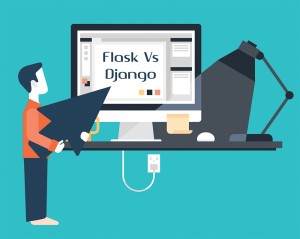Flask Vs Django

Flask and Django are two of the most popular web frameworks for Python. In this article, we will be discussing some of the points you should consider while choosing between Flask and Django.
WHAT IS DJANGO AND WHAT DOES IT DO?
Django is a well-sophisticated framework aimed at rapid deployment and development of numerous web apps written in Python. This framework is distributed as an open-source. The framework itself is actually a code library, which helps the developers in building reliable, scalable, and workable web apps. Django is one of the most popular frameworks from a wide variety, available to Python developers. There is one limitation though: some things are envisioned to be done in one and the only way.
You can replace certain modules yet some core functionality should remain untouched. This is totally fine in 95% of the projects, and it saves a ton of time, money, and effort during development, as the users will have all the solutions they need straight out of the box.
WHAT IS FLASK?
Flask is another widely used web framework. Differing to Django, it is focused on at providing an out-of-the-box product with complete solutions for each task, Flask works more like a LEGO set, where the user can construct anything he/she wish, using an enormous set of external libraries and add-ons. Flask philosophy is “web development, one drop at a time”. Python developers with huge experience say that Flask enables adding new modules when the time comes, instead of overwhelming the users with the details from the very beginning.
LET’S TAKE A CLOSER LOOK AT WHAT POSSIBILITIES DJANGO HAS TO OFFER
- Object Relational Mapping allows working with several types of databases such as SQLite, Post greSQL, Oracle and MySQL.
- Celery allows doing asynchronous tasks and replacing unix crontab for cron jobs.
The user can use Gunicorn instead of Apache; it’s easy and fun (if the user has no trouble with using NGINX). - If the developers are more skilled enough, then the user can use MongoDB as a primary database; this solves quite a lot of problems later on.
- Using named URLs, reverse function, and the URL template tag allows creating a logically structured system, where one URL update will not inflict confusion.
- Using supervisor for process monitoring lets restart the framework processes automatically; it is truly a rescuer during development stage.
- Redis is a valued in-memory data structure store, which can be used for queuing celery jobs, as a cache, as a store for sessions, even for auto-completion and much more.
- Munin and statds are another great pair of apps, allowing control and monitoring of the users Django app processes.
- As we can see from the list of websites using this framework, it is planned for creating apps with high scalability; websites that grow from thousands to millions of visitors quickly. This framework works straight out of the box and provides all the major functionalities needed to build an app with Python.
LET US TAKE A LOOK AT FLASK ARCHITECTURE AND FUNCTIONALITY
- Flask is all about simplicity and ease. There are no limitations and the user can implement anything they want it.
- No database access layer and ORM. Other apps like SQLAlchemy or pure SQL queries do this job without any restrictions.
- Routing with decorators is really simple; app structure is also totally adjustable.
Blueprints are like modules for the application. The user can have lots of them suited for any task and construct to their app like a LEGO toy, using the blueprints best suited for this particular task and the extensions are incredibly helpful and are integrated into the framework easily. - Web server and debugging tools: Flask comes with in-built web server and multiple debugging tools, including the in-browser, so the user do not even need NGINX or Apache to test and debug the app.
- Flask appeared as a substitute to Django, as developers chosen to have a micro framework that would allow them using varying components, and neither of previous frameworks allowed alteration of their modules to some extent. Flask is simple and straightforward thus working in it allows an experienced Python developer in creating projects within short timeframes.
THE VERDICT
Flask works like a sandbox for developers, where they can improve their skills and quickly test solutions using different modules and libraries. We prefer using it for testing and working on less-structured objects, while using Django to deliver a solid product, meeting and exceeding customer’s expectations.

